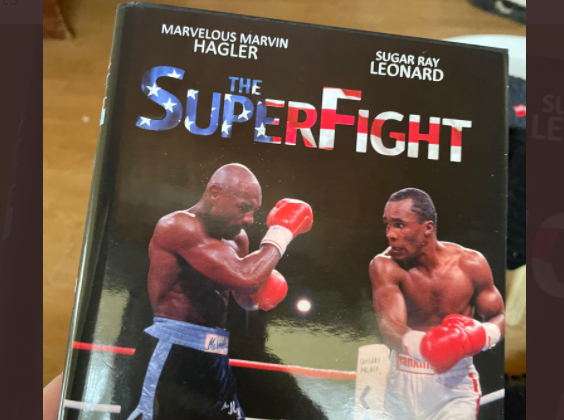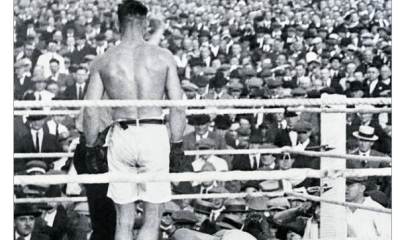Book Review
“The SuperFight” Marvelous Marvin Hagler vs. Sugar Ray Leonard

BOOK REVIEW by Thomas Hauser — Sugar Ray Leonard and Marvin Hagler were two of the greatest fighters of all time. On April 6, 1987, they met in the ring at Caesars Palace in Las Vegas in one of the most anticipated fights ever. The SuperFight by Brian Doogan (published by Brian Doogan Media) revisits that historic encounter and puts it in context.
“Leonard,” Doogan writes, “was Ali’s successor, the most charismatic, bankable, and virtuoso exponent of his trade. The standard-bearer for his sport. Apolitical with multicultural appeal, courted by corporate America, championed by the TV networks, paraded and fawned over on the chat show circuit. The cool acceptable face of a dark, squalid, ultimately indefensible profession.”
Or phrased differently, as Mike Tyson put it, “Ray Leonard was a pitbull with a pretty face” who became the highest paid athlete of his time.
Hagler loved the craft and hated the business of boxing. His early years were spent in riot-torn Newark, New Jersey. His mother moved the family to Brockton, Massachusetts, where Marvin dropped out of high school after fathering a son. Trained and managed by Goody and Pat Petronelli, he earned his championship by cutting a wide swath through the middleweight division.
“Hagler has done everything you could ask of a champion,” Hall of Fame great Archie Moore said after Marvin (or, as he was legally known by then, “Marvelous Marvin”) destroyed Thomas Hearns over three of the most enthralling rounds in boxing history. “He’s fought one top contender after another and beaten them all. I rate him right up there with Sugar Ray Robinson. He’s a hard hitter with both hands. And he’s cruel in the ring, like a great fighter must be.”
Hagler was hard-working, disciplined, and honest. Pure fighter, if there is such a thing. “His aura,” Doogan observes, “spoke for him.”
“I’ve gotten meaner since I became champion,” Hagler noted. “They’re all trying to take something from me that I’ve worked long and hard for years for. And I like the feeling of being champ.”
For most of their respective ring careers, Leonard and Hagler plied their trade in parallel universes, dominating the welterweight and middleweight divisions. The thirteen-pound weight differential between them was considered too wide to bridge. From time to time, Ray dangled the possibility of a super-fight in front of Marvin in the manner of Lucy pulling the football away from Charlie Brown in the Peanuts comic strip of that era. But he was toying with Hagler. And over time, Marvin’s resentment grew, fueled by the disparity in purses between them.
Mike Trainer was a constant throughout Leonard’s ring career. Ray trusted the attorney to look after his business interests, and Trainer did so brilliantly.
Hagler’s purse for his first pro fight was forty dollars. Leonard, the darling of the United States boxing team at the 1976 Olympics, made $50,000 for his pro debut. Leonard earned $1,000,000 for his first title opportunity against Wilfred Benitez. Hagler’s first title challenge was against Vito Antuofermo on the undercard that night. Marvin was paid $40,000. And he got screwed by the judges, who ruled the bout a draw.
Four fights later, Hagler earned a second title shot, this time against Alan Minter who he stopped in three rounds. Marvin’s purse that night was $150,000. Meanwhile, Leonard was paid $17 million for two fights against Roberto Duran (a loss avenged in an immediate rematch) and $12 million (equal to more than $35 million today) for knocking out Thomas Hearns.
“No one,” Doogan writes, “wanted to take a look beneath the mask that was Sugar Ray, the ATM machine for family and friends, the all-American and international star, [But] to Hagler, he was always ‘pretty boy’ – a description the middleweight king spat out with contempt. The antithesis in almost every respect of the spartan blue-collar outsider who, by overwhelming force of will, climbed the ranks to establish himself as the feared ruler of the sport’s red-light district.”
Five months after beating Hearns, Leonard disposed of Bruce Finch in three rounds. Then he suffered a detached retina and left boxing, only to return in 1984 to fight Kevin Howard. Howard knocked Ray down – the first time in Leonard’s career that he’d been on the canvas. Ray prevailed on a ninth-round stoppage that brought his record to 33-1. But he’d looked mediocre, and the assumption was that his days as an elite fighter were over.
Meanwhile, Hagler was becoming increasingly marketable with victories over Duran and Hearns elevating him to superstar status. On March 3, 1986, he added to his laurels by stopping John Mugabi in eleven rounds.
But against Mugabi, Hagler seemed to be slipping a bit. And outside the ring, for the first time, he was growing ambivalent about fighting.
At the same time, Leonard was getting an itch that he had to scratch. Commenting during the telecast of Hagler-Hearns, Ray acknowledged, “I would be lying if I told you I didn’t envy those two men up there right now. There is a lot you don’t miss in boxing. You don’t miss the roadwork while the rest of the world is sleeping. You don’t miss all the hype, all the promotion. But you do miss moments like these. You miss the feeling that, for a little time, the whole world is looking at you and the guy you are fighting. You miss the fact that, for a few days of your life, you’re at the dead center of the world.”
Offers for Hagler vs. Leonard were forthcoming. Despite Hagler’s ebbing desire, it was a fight that Marvin had to take. Bob Arum, who would promote the bout, said as much when he declared, “If Leonard decides not to accept the offer, I think Marvin would be delighted. He really and truly doesn’t want to fight Leonard. He’s doing it to protect his reputation.”
Eventually, a deal was reached. For only the third time in his ring career, Leonard would be on the short end of a purse split. Leonard-Benitez and Duran-Leonard II had been the first two instances. This time, after all the revenue streams were added up, Team Hagler would take home roughly $20 million while Leonard’s end would be $12 million.
But in exchange, Leonard received several significant concessions. The fight would be twelve rounds, not fifteen. It would be contested in a 20-foot ring. The fighters would wear ten-ounce gloves instead of eight. And because Ray had previously suffered a detached retina, the fighters would wear thumbless gloves.
“I’m not coming back to have a career,” Leonard said. “I’ve had a career. I want Marvin.”
Hagler was a 7-to-2 betting favorite.
In the preceding five years, Leonard had fought once – his unimpressive outing at 149 pounds against Howard. Now he’d be fighting the dominant middleweight of his time and one of the greatest fighters ever.
Previously, Emanuel Steward (who trained Thomas Hearns) had opined, “A Hagler-Leonard fight would be a fraud on the public. It would be another Larry Holmes – Muhammad Ali show. A hoax.”
The sporting press was in accord:
* Hugh McIlvanney (The Observer): “I think it’s ludicrous that Sugar Ray should be able to come back after one fight in more than five years – nine very unimpressive rounds – and step into a world championship fight. We all love Sugar Ray. He possessed everything essential to the great man’s fighting armoury. Superb technique, speed, fluency, imagination, punching power, and a strong chin. And behind his dazzling good looks and the readily summoned charm, there was the remorselessness of a street fighter. But what is being said about him now by his admirers relates mainly to what he was. I think he is more memory than substance.”
* Jim Murray (The Los Angeles Times): “You look at Sugar Ray Leonard and you want to take him to lost-and-found and buy him an ice cream cone until you can find his mother and father. You look at Marvelous Marvin Hagler and you wonder where the police are when you need them. If this is a contest, so is a train wreck.”
* Tom Boswell (The Washington Post): Hagler is the embodiment of the fighter we don’t want Leonard to fight. Hagler hurts you. He changes you. Permanently.”
“If he’s foolish enough to step in the ring with me, I’m foolish enough to rip his eye out,” Hagler said ominously. “Nobody is going to want Leonard when I get through with him. I’m gonna rip his brains out. Ray says he’ll use strategy. But I’ll be using something called punching. This guy is just a pretty boy.”
Sixty of 67 writers polled on site predicted that Hagler would win, 52 of them by knockout.
“It was almost like we were going to a hanging,” HBO commentator Barry Tompkins later reminisced “That was the mood in the air that week in Las Vegas. People thought there’s no way Ray Leonard can win this fight and, essentially, we’re about to watch an execution.”
“Maybe I don’t hit as hard as Marvin, but I hit consistently, “Leonard offered in response. “If I’d always heeded everybody’s advice, I would have stayed in school and never boxed.”
Hagler was 32 years old. Leonard was 30. In 1987, that was getting on in age for a fighter.
Earlier in his career, Leonard had battled an addiction to cocaine. Now that was behind him. Hagler, by contrast, had dabbled with cocaine after beating Hearns. Except with cocaine, it’s hard to just dabble.
More to the point; prior to fighting Leonard, Hagler had said, “For me, the fight with Tommy was World War I. This fight is World War II.” But when the bell for round one against Leonard rang, Marvin didn’t fight like it.
Richard Steele (who refereed Hagler-Leonard) later recalled, “I saw something different about Hagler. He wasn’t himself. As the fight unfolded, I began to realize he was trying to be a boxer instead of the fighter he really was. His ‘destruct and destroy’ mindset was what got him to be the great fighter, the great champion he was. But Leonard had won the mental battle. He got Hagler to change his style.”
Most notably, Hagler gave away the first three rounds by fighting from an orthodox stance instead of his usual southpaw stance. That would cost him dearly.
Equally important, Barry Tompkins later revealed that, before the fight, Leonard had confided in him, “I’m going to tell you how you beat Marvin Hagler. You’ve got to fight three times a round for fifteen seconds. At the beginning of the round, in the middle of the round, and you have to do it again at the end of the round. And you’ll steal the fight.”
When it was over, Dave Moretti scored the bout 115-113 for Leonard. Lou Filippo favored Hagler by a 115-113 margin. The deciding vote was cast by Jo-Jo Guerra whose scorecard was an inexplicable 118-110 in favor of Leonard. Guerra’s scorecard cast a stench over the proceedings. Had he scored the bout 115-113 for Leonard, the verdict would have been less controversial.
For the record; I scored Hagler-Leonard twice – once in a theater watching on closed-circuit TV and later viewing a replay on television. Each time, I scored the bout a draw.
“The truth is really simple,” Hagler said bitterly afterward. “And everybody knows it. Leonard didn’t come to fight. He came to run all night. With the politics, I knew if Leonard stayed on his feet, I was probably gonna lose. And he ran and survived.”
But Leonard wasn’t trying to win a war. He was trying to outpoint an opponent and win a prizefight. As Doogan states, “Whatever the vagaries of the scoring, the reality is Hagler was unable to make good on his vow while Leonard, against all odds, continued to execute his battle plan.”
Hagler never fought again. He retired and stayed retired, moving to Italy and landing roles in four action films.
“You always need to have another road ahead of you,” Marvin said of his new life. “If you ever feel it’s done, then it is done and you’re done too. You’ve always got to keep reaching and striving.”
Leonard, it turned out, was more of a junkie for boxing that Hagler was. Having engineered one of the greatest comebacks in boxing history, Ray would fight five more times over the next ten years, ending his illustrious career on losses to Terry Norris and Hector Camacho, both of whom did to him what people had thought Hagler would do.
The SuperFight is a good book. Brian Doogan did his homework conscientiously. He writes smoothly and fashions compelling portraits of Leonard and Hagler, bringing both men to life. He recounts the key fights in each man’s career leading up to their April 6, 1987, encounter and also their lives outside the ring, including Leonard being sexually abused multiple times as an adolescent, Ray’s troubled first marriage, and the descent into cocaine that almost destroyed his life.
Hagler’s life is similarly explored. One of many whimsical details Doogan recounts that caught my eye is the recollection of Robbie Sims (Marvin’s half-brother) who says of their childhood years, “Every day, he made sure I made my bed, cleaned my side of the room, put my shoes away and the dirty clothes in the dirty-clothes bag.”
Hagler succumbed to an apparent heart attack at age 66 on March 13 of this year. It’s a tragedy that he died as young as he did,
Thomas Hauser’s email address is thomashauserwriter@gmail.com. His most recent book – Staredown: Another Year Inside Boxing – was published by the University of Arkansas Press. In 2004, the Boxing Writers Association of America honored Hauser with the Nat Fleischer Award for career excellence in boxing journalism. In 2019, he was selected for boxing’s highest honor – induction into the International Boxing Hall of Fame.
Check out more boxing news on video at the Boxing Channel
To comment on this story in the Fight Forum CLICK HERE
-

 Featured Articles4 weeks ago
Featured Articles4 weeks agoThe Hauser Report: Cinematic and Literary Notes
-

 Book Review3 weeks ago
Book Review3 weeks agoMark Kriegel’s New Book About Mike Tyson is a Must-Read
-

 Featured Articles2 weeks ago
Featured Articles2 weeks agoThe Hauser Report: Debunking Two Myths and Other Notes
-

 Featured Articles3 weeks ago
Featured Articles3 weeks agoMoses Itauma Continues his Rapid Rise; Steamrolls Dillian Whyte in Riyadh
-

 Featured Articles4 weeks ago
Featured Articles4 weeks agoKotari and Urakawa – Two Fatalities on the Same Card in Japan: Boxing’s Darkest Day
-

 Featured Articles2 weeks ago
Featured Articles2 weeks agoNikita Tszyu and Australia’s Short-Lived Boxing Renaissance
-

 Featured Articles3 weeks ago
Featured Articles3 weeks agoIs Moses Itauma the Next Mike Tyson?
-

 Featured Articles4 weeks ago
Featured Articles4 weeks agoRamirez and Cuello Score KOs in Libya; Fonseca Upsets Oumiha




















